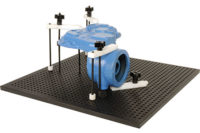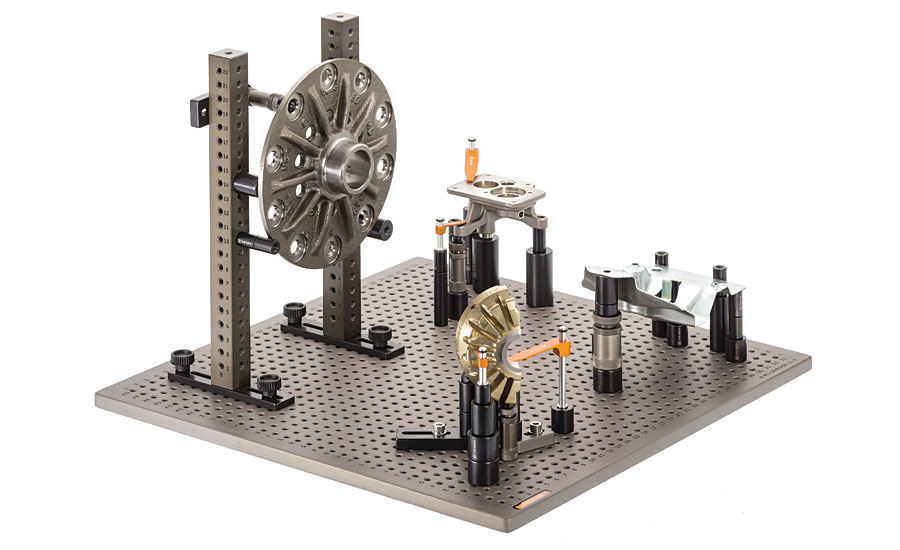Measurement
Don’t Forget Fixturing
Fixturing is frequently overlooked when purchasing coordinate measuring machines and vision or flexible gaging systems.

Modular fixtures support a range of components using clamps, towers and magnets. Source: Renishaw

Vision fixtures are purposely designed to inspect small and intricate parts with a range or micro fixturing components as well as clamping solutions. Source: Renishaw


When purchasing coordinate measuring machines (CMM) and vision or flexible gaging systems, fixturing is often overlooked until the inspection equipment has been commissioned and the first parts need to be measured. To avoid delays, fixturing requirements should be well understood and addressed while a project is still in the planning stages. Even long after the equipment has been commissioned, many machines continue to be underproductive and cause backlogs in the inspection process, which is a direct result of inadequate fixturing.
Historically, fixtures were designed and built as if they were gages. Inspection equipment was often manually operated and not programmable. The software used to control it was not as capable of processing the information as it is today. Fixturing was designed to present the part to the probe head or camera in the most efficient way, and multiple stations were frequently required to access all critical features. Fixtures were also expected to position a part to all of its primary datums, which would often require a complicated design. Over the years, CMMs, vision and gaging systems have become more sophisticated and less dependent on overly complex fixturing. Advances in the machines and software have allowed inspection equipment to measure parts more quickly and more intelligently. Fixturing is now facing new challenges, yet remains key to the success of any inspection.
CUSTOM OR MODULAR FIXTURING
Tech Tips
|
Two types of fixturing are used, depending on the application: custom or modular.
Modular fixtures are capable of fixturing most parts and presenting them in the optimal position to the inspection equipment. They also handle a variety of part materials and shapes. They are designed to fixture the part and provide the flexibility to change over for another part in the future. Base plates are the foundation of every setup and are available in aluminum and clear acrylic, in a range of sizes to suit the application or the dimensions of the CMM, vision or gaging system. Many fixture plates are alphanumerically labelled to help document and record the fixturing setup for future use, and to comply with quality standards. A wide selection of fixturing components is available to help elevate, locate and secure a part into a specified position. Adjustable components are designed to level complex parts or fixture them in a desired position for the most efficient inspection. Further components include clamps, magnets or suction cups, all ideal for securing a part.
Some applications may require multiple modular fixtures to keep setups assembled for faster or recurring inspections. This allows for the flexibility of a quick changeover and can also increase the throughput of the inspection equipment as it is possible to start the inspection as soon as the system becomes available.
Custom fixtures are best suited for high-volume production or parts with complex geometry. A custom fixture is designed to accommodate the part and present it to the inspection equipment in the best position. It can also use different methods for positioning and securing a part in place.
When custom fixtures are needed, it is best to contact a fixture company familiar with CMMs, gaging and vision systems. It is important to encourage communication between the fixture company’s design engineer and the application engineer or inspection technician who is responsible for programming the part inspection. This way all fixturing requirements can be addressed, including the type of probing or back-lighting needed to make sure all critical features can be accessed for inspection and that there is no interference between the inspection equipment and the fixture.
Custom fixtures are often designed to provide durability when parts are inspected daily in high-production environments. Some applications require ‘families’ of parts to be inspected in batches of 10, 25 or even 50 at a time. This allows the inspection equipment to measure more parts with minimal downtime needed to load and unload parts. Custom fixtures are also needed when the parts geometry is so complex that the only option to inspect it accurately and efficiently is to use a bespoke design. Again, working with a fixture company and the inspection equipment manufacturers or distributors should help achieve high productivity from the inspection equipment.
FIXTURE CONSIDERATIONS AND PLANNING
Many CMM and vision system manufacturers and distributors do not emphasize the need for fixturing. Given the strong competition and ever-increasing pressure to keep prices low, the industry finds it difficult to give a potential customer a complete solution at an additional cost. The initial quoting process should ideally give options for fixturing and probing. Unfortunately, when the customer receives the quotes and some of them do not list fixturing or other options, they are led to believe that these are not needed. This is despite the fact that many companies are looking to their suppliers for a complete solution. If fixturing is omitted from the quote and order, it is not uncommon that when the inspection equipment is delivered to the facility, productivity is compromised until suitable fixturing is arranged. Fixturing requirements need to be addressed well before purchasing decisions are made, more so if custom solutions are necessary.
The need for fixturing in CMMs and vision inspection applications is no different than fixturing for metal cutting applications. Rarely is the machining equipment purchased without fixturing for a production application. The same should apply to the part inspection.
Whether purchasing a CMM, vision or gaging system, keep in mind that the success of any inspection equipment is quicker when fixturing is a priority. Modular or custom fixturing is the key to getting the complete part inspection solution. Q
Looking for a reprint of this article?
From high-res PDFs to custom plaques, order your copy today!






